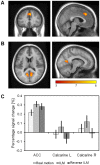Neural correlates of illusory line motion
- PMID: 24475313
- PMCID: PMC3903774
- DOI: 10.1371/journal.pone.0087595
Neural correlates of illusory line motion
Abstract
Illusory line motion (ILM) refers to a motion illusion in which a flash at one end of a bar prior to the bar's instantaneous presentation or removal results in the percept of motion. While some theories attribute the origin of ILM to attention or early perceptual mechanisms, others have proposed that ILM results from impletion mechanisms that reinterpret the static bar as one in motion. The current functional magnetic resonance imaging study examined participants while they made decisions about the direction of motion in which a bar appeared to be removed. Preceding the instantaneous removal of the bar with a flash at one end resulted in a motion percept away from the flash. If this flash and the bar's removal overlapped in time, it appeared that the bar was removed towards the flash (reverse ILM). Independent of the motion type, brain responses indicated activations in areas associated with motion (MT+), endogenous and exogenous attention (intraparietal sulcus, frontal eye fields, and ventral frontal cortex), and response selection (ACC). ILM was associated with lower percept scores and higher activations in ACC relative to real motion, but no differences in shape-selective areas emerged. This pattern of brain activation is consistent with the attentional gradient model or bottom-up accounts of ILM in preference to impletion.
Conflict of interest statement
Figures




References
-
- Zeki S, Watson JDG, Frackowiak RSJ (1993) Going Beyond the Information Given - the Relation of Illusory Visual-Motion to Brain Activity. Proceedings of the Royal Society B-Biological Sciences 252: 215–222. - PubMed
-
- Kuriki I, Ashida H, Murakami I, Kitaoka A (2008) Functional brain imaging of the Rotating Snakes illusion by fMRI. Journal of Vision 8.. - PubMed
-
- Goebel R, Khorram-Sefat D, Muckli L, Hacker H, Singer W (1998) The constructive nature of vision: direct evidence from functional magnetic resonance imaging studies of apparent motion and motion imagery. European Journal of Neuroscience 10: 1563–1573. - PubMed
Publication types
MeSH terms
LinkOut - more resources
Full Text Sources
Other Literature Sources

